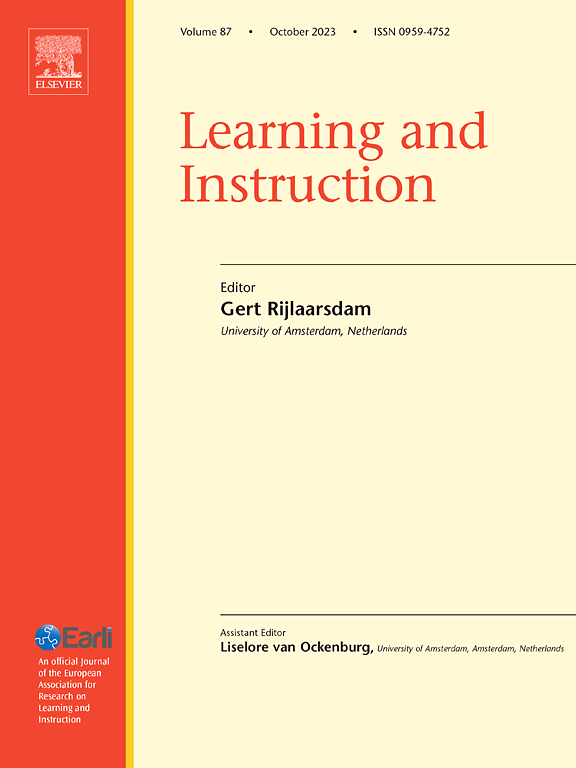Relevance of student motivation for providing high-quality peer-feedback: Results of two field studies
IF 4.9
1区 教育学
Q1 EDUCATION & EDUCATIONAL RESEARCH
引用次数: 0
Abstract
Background
The prevailing interest in peer-feedback practices in higher education is grounded in their potential to foster students' learning, understanding, and performance while reducing instructor workload. This potential depends on students' motivation to provide high-quality peer-feedback. Within this, students’ expectancies for and the value they place on peer-feedback provision as well as their achievement goals seem to be particularly impactful. However, barely any research has investigated these relations.
Aims
We aim to explain differences in peer-feedback quality based on feedback providers’ motivation in terms of mastery goals (task and learning goals), work avoidance goals, expectancies for success, task value, and cost.
Methods and Sample
To answer these questions, we conducted two field studies in higher education courses in which 254 and 173 students provided peer-feedback on written assignments. Students reported their mastery goals, work avoidance goals, expectancies for success, task value, and cost regarding the task right before providing feedback. This feedback was assessed in terms of its quality along three aspects: criteria-based rating by trained raters, receiver-perceived quality, and feedback length.
Results
Consistently across both studies, path models showed that particularly task goals and utility value mattered for high-quality peer-feedback. Expectancies for success and cost were partly positively associated with feedback-quality.
Conclusions
The motivation of students providing peer-feedback seems to be relevant for the quality of the peer-feedback they provide and is thus a crucial factor to consider in instructional settings implementing peer-feedback. Within this, particularly the effects of cost warrant further investigation.

学生提供高质量同伴反馈动机的相关性:两个实地研究的结果
在高等教育中,对同伴反馈实践的普遍兴趣是基于它们在减少教师工作量的同时促进学生学习、理解和表现的潜力。这种潜力取决于学生提供高质量同伴反馈的动机。在这种情况下,学生对同伴反馈的期望和价值以及他们的成就目标似乎特别有影响力。然而,几乎没有任何研究调查过这些关系。目的我们的目的是根据反馈提供者在掌握目标(任务和学习目标)、工作回避目标、对成功的期望、任务价值和成本方面的动机来解释同伴反馈质量的差异。方法和样本为了回答这些问题,我们在高等教育课程中进行了两项实地研究,其中254名和173名学生提供了书面作业的同行反馈。学生在提供反馈之前报告了他们的精通目标、工作回避目标、对成功的期望、任务价值和任务成本。根据三个方面对反馈的质量进行评估:由训练有素的评分员进行的基于标准的评分,接收者感知的质量和反馈的长度。结果在两项研究中,路径模型一致表明,任务目标和效用价值对高质量的同伴反馈至关重要。对成功和成本的期望与反馈质量部分正相关。结论:学生提供同伴反馈的动机似乎与他们提供的同伴反馈的质量有关,因此是在实施同伴反馈的教学环境中考虑的关键因素。在这方面,特别是费用的影响值得进一步调查。
本文章由计算机程序翻译,如有差异,请以英文原文为准。
求助全文
约1分钟内获得全文
求助全文
来源期刊

Learning and Instruction
Multiple-
CiteScore
11.30
自引率
4.80%
发文量
109
期刊介绍:
As an international, multi-disciplinary, peer-refereed journal, Learning and Instruction provides a platform for the publication of the most advanced scientific research in the areas of learning, development, instruction and teaching. The journal welcomes original empirical investigations. The papers may represent a variety of theoretical perspectives and different methodological approaches. They may refer to any age level, from infants to adults and to a diversity of learning and instructional settings, from laboratory experiments to field studies. The major criteria in the review and the selection process concern the significance of the contribution to the area of learning and instruction, and the rigor of the study.
 求助内容:
求助内容: 应助结果提醒方式:
应助结果提醒方式:


